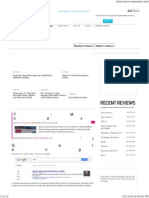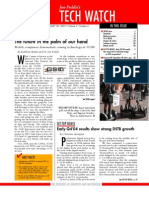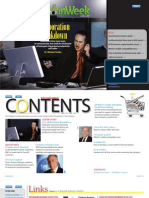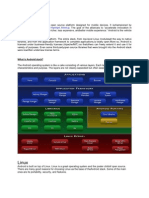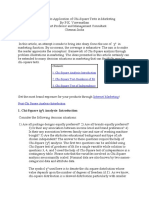Comm Tech Update CES Reflections
Comm Tech Update CES Reflections
Uploaded by
Thomas NeuhausCopyright:
Available Formats
Comm Tech Update CES Reflections
Comm Tech Update CES Reflections
Uploaded by
Thomas NeuhausOriginal Description:
Copyright
Available Formats
Share this document
Did you find this document useful?
Is this content inappropriate?
Copyright:
Available Formats
Comm Tech Update CES Reflections
Comm Tech Update CES Reflections
Uploaded by
Thomas NeuhausCopyright:
Available Formats
BRIGANTINE ADVISORS Communications Technology
Comm Tech Update January 10, 2011
PLEASE SEE PAGE 7 FOR IMPORTANT Kevin Dede, CFA
DISCLOSURES. (415) 779-5876
kevin.dede@brigantineadvisors.com
CES 2011 Reflections:
Wireless Connectivity
Proves to be an Acute
Need as the Dawn of a
New Decade Unfolds
Summary: The Consumer Electronics Association hosted its annual CES trade show last week
where some 130,000 unsuspecting yet good natured show goers proceeded to trip, push and
shove each other in effort to fondle such goodies as Samsung's Galaxy Tab and HTC's HD7
Windows Mobile 7 Series phone on T-Mobile's network. For the life of us, we'll never understand
why these people just didn't stay home and play with the old toys in their local neighborhood cell
phone stores. Be that as it may, this year's show certainly stands as testament to the health of
global consumerism. Could it be unscrupulous, irresponsible bureaucratic leadership and the
resultant endless governmental money printing at major central banks around the world that led
to the overflowing halls of the Las Vegas Convention Center, closing in on the record 2007
attendance of 143,695 at the height of the most recent bubble? While it stands to reason that
people are always going to want the coolest and the newest, all the newest and the coolest at this
year's show was somehow, one way or another, wirelessly connected as never before.
Now your tablet can have a tablet. Some time ago, back in the dark ages before the Verizon
iPhone, a select group of professional prognosticators working as analysts at CEA thought that
there might be as many as 80 tablets shown at CES 2011. Clearly things can change quickly, and
just about three months later on January 4, 2011, that same select group revised its standing
estimate to perhaps more than 100 possible tablet introductions at CES. At the show last week,
we completely lost count. We'll admit that right up front. Companies we've never heard of, such
as Cody, were proudly displaying tablets; in fact, Cody had three versions of its new Kyros tablet
in its booth last week, all of which run Android 2.1. But the segment ground breaker in our eyes
was Motorola's Xoom, the tablet all tablets want to be when they grow up. Running on Verizon's
3G network in 1Q11, but upgradeable to 4GLTE in 2Q11, Xoom has a dual core 1 GHz processor
for a brain and in 2Q, arguably the fastest legs in the business. If those little features aren't
enough for you, how about Google's new Android 3.0 operating system affectionately known as
Honeycomb, specifically developed to make tablet computers fun? Intuitive gestures on the touch
screen call up menus and display widgets in a new, cool way. While the device was on lock down
and carefully monitored by a cadre of Motorola goons so no one outside of Motorola booth staff
could touch it, we undauntedly subjected ourselves to the pre-programmed demo multiple times
to glean an understanding to what could ultimately be the way we all interact with computers in
the future. Sure, we're gluttons for punishment, but look, we actually see a trend unveiling itself.
Think Tom Cruise in Minority Report. No, we're not saying Android 3.0 can anticipate crimes
ahead of the act, but we certainly believe large screen, multi-touch, multi-sensor driven inputs are
coming to mainstream computing, and it won't be long before most of us toss out our keyboards.
Look to interactive gaming as a guide as well. Microsoft's Xbox Kinects uses optical sensors,
Nintendo's Wii uses motion detectors, and the Razer Onza game controller uses, believe it or not,
changes in magnetic fields to allow players to manipulate either their avatar or a device in a
computer game with one millimeter accuracy, and all while not in direct touch of the computer, its
January 10, 2011 1
BRIGANTINE ADVISORS Communications Technology
screen, or a keyboard. Seeing all this in one place explains why we were in Vegas. Honeycomb
requires a user to physically touch the screen, but it registers that sensation in a manner we
might expect French lovers to react. All sorts of unexpected things happen when you touch it the
right way. Motorola wasn't the only OEM to be granted exalted status. LG introduced the G-Slate
for T-Mobile and it too sports Honeycomb. But at the time this went to press, that's the exclusive
Honeycomb list.
Another potential winner from Motorola could be the Atrix, powered by a dual core 1 GHz
processor. Slated to run on AT&T's network, the Atrix forms the path for handsets to replace
desktops in an enterprise setting. The power behind Atrix rivals desktop PCs a mere three years
old, and with that kind of horsepower, why the heck not use it as a desktop or a laptop? Motorola
sure thought so, so it built two Atrix docking stations, one for each computing venue. With all
that in mind, why not have your tablet power a tablet?
People are tired of cable companies. Everybody loves broadband, and with a sharp eye
toward the future perhaps one can see how MSOs evolve to mere purveyors of bandwidth going
forward as triple-digit cable bills tend to leave a sour taste in the mouth during these lean times.
Last year, CES was all about 3D TV. This year, as hard as the big TV companies are trying to
make good on keeping the 3D investment alive, but perhaps reeling from the whopping 1.1 million
3D sets sold in the U.S. last year, the emphasis at CES changed a bit this year. Almost every,
top-of-the-line large screen TV was deemed Internet-ready and most also had wireless networking
built right in. The 802.11n Wi-Fi standard can handle multiple HD video streams simultaneously,
and it appears that the TV OEMs realize that wireless connections are easier for consumers all
around; Cavium Networks stands as the biggest beneficiary we see as this technology moves to
the mainstream. That company made its CES debut last week touting its inclusion in OEM
products. And much more this year than last year are companies willing to help consumers find
and distribute Internet TV content, such as Vudu, Hulu, iGUGU, Roku, and perhaps assorted other
'-u's and even some non-u's such as Boxee Box. We think the wirelessly networked, Internet-
ready TV phenomenon had the most profound effect on us. From a networking hardware
perspective, TV's come with an assortment of hard line connections, including Cat5 cable input,
HDMI and Ethernet RJ-45 jacks, and now even Wi-Fi. Yes folks, the world is going wireless.
Have we found the answer to the "killer app" question? Video, video, video is the killer
app, and we're bound to continue to repeat ourselves. Fast networks share bandwidth hungry
video, and while video conferencing is nothing really new, available on ISDN H.323 some ten
years ago, it seems to have found more interest via Skype and Apple's FaceTime. The
combination of display technology, network speeds, and 1080p HD video clarity pushing its way on
to top-tier handsets is certain to propel video consumption further. Of the four new LTE handsets
Verizon showed off from Samsung, Motorola, LG, and HTC, two of them have mini HDMI ports that
can connect directly to 1080p large screen TVs and provide that same HD experience. Perched
above all handsets, in our mind, is Sony Ericsson's Xperia Arc also announced last week. Although
not yet available, we were able to get our hands on one at the show to personally witness the
prowess of Sony's Bravia video engine applied to a 4.2 inch "reality" screen. We haven't seen
anything portable display video like it. Powered by a 1GHz processor and running Android 2.3,
this handset ranks with the best of them in our opinion, but we're uncertain of what version of
HSPA+ the radio might support—this, of course, begs another question we address in the next
section of this paper. We certainly offer kudos to the crispness of Samsung's Super AMOLED Plus
screen debuting on its "4GLTE" handset for Verizon (and AT&T's Infuse handset) last week, but
the perceived depth of field presented in Sony's technology appears unparalleled. With no carrier
yet announced for Xperia Arc, we see a great handset, and perhaps the greatest, not winning the
recognition it deserves.
Lending credibility to our video killer app theme is the direction major semiconductor companies
January 10, 2011 2
BRIGANTINE ADVISORS Communications Technology
are taking their research and development. Intel's introduction of its Sandy Bridge chip that
embeds graphic logic (GPU or graphics processing unit) and AMD's Fusion finally incorporating the
graphics capability acquired in the $5.4 billion ATI acquisition of 2006. In our opinion, Intel
appears to be on the right course here for a few reasons: (1) for the past three years running,
according the annual CEA survey, notebooks and laptop PCs have stood unchanged at the top of
the most desired consumer electronics product list, above mobile phones, iPads, iPhones, and
assorted other items; and, (2) Intel's Sandy Bridge is coming on Intel's new 32 nanometer
processing technology, offering superior performance per given unit of semiconductor real estate—
AMD's devices are leveraging the same technology to attack the same market—adding efficacy to
our killer video thesis. Video consumption in handheld and portable devices on the back of
Nvidia's Tegra 2 chip, sporting dual cores and sized smaller than a dime, implies delivering more
video to the masses and again reaffirming video consumption standing as the killer application.
4G, myth or legend? Can it leap tall buildings in a single bound as Nvidia's CEO, Jen-Hsun
Huang, intimates? Is it Apple's latest iPhone? Is it Sprint's WiMAX? Perhaps the most confusing
issue in consumer electronics today is the definition of 4G. We won't bring peace in this time of
the 4G wars, but hopefully we can explain away some of the confusion. T-Mobile claims 4G is
about network performance. Performance means many things in and of itself: upstream and
downstream speeds as well as latency. Speeds are self explanatory, and latency, a synonym for
delay experienced on networks, is an expression of how much time it takes for a packet of data to
get from one designated point to another. Measuring networks based on these characteristics is,
we think, the optimal way to measure "performance."
Meanwhile, the ITU (International Telecommunications Union), an organization revered for many
things among them defining things telecoms related, revised its former definition of 4G in a
December 6 press release that included the following passage: "…IMT-Advanced is considered as
"4G", although it is recognized that this term, while undefined, may also be applied to the
forerunners of these technologies, LTE and WiMax, and to other evolved 3G technologies providing
a substantial level of improvement in performance and capabilities with respect to the initial third
generation systems now deployed…" implying that performance improvement is a fair way to
judge 4G networks. Okay, we can now agree that performance is the ultimate criterion, but how
to look at performance improvement?
T-Mobile Explains HSPA Upgrade Path at CES Press Event
Source: CNET
A metaphor representing just how fuzzy consumer recognition of 4G is, the lack of clarity in the
picture above didn't deter our mission to illustrate the path to greater speeds leveraging existing
January 10, 2011 3
BRIGANTINE ADVISORS Communications Technology
HSPA technology (based on CDMA), and T-Mobile believes its network covering 200 million pops
with 21 Mbps HSPA+ qualifies as 4G. Certain geographies of its network are slated to upgrade to
42 Mbps as 2011 progresses. While theoretical measures of speed are one view, actual
experienced network speeds are another and are often a function of how much load the network is
bearing. AT&T and its iPhone experience through the 2008 and 2009 time frame is a fantastic
example of total network degradation. Performance became so bogged down in both New York
City and San Francisco in the fall of 2009, that AT&T removed the iPhone from its website in both
these selling geographies. Verizon claims its LTE network should continue to support 5 to 12 Mbps
downlinks as the network loads up with subscribers, while common experience on Sprint's WiMAX
is in the area of 2 to 3 Mbps; these networks use an entirely different technology called OFDMA,
which is completely removed from the underlying CDMA technology of HSPA. Prior to a
convention born from common discussion, 4G was expected to come only from OFDMA-based
technologies, but that has obviously changed.
Finally, perhaps the most over looked characteristic, is the phone or device's own modem. Given
that there are so many variants of wireless technology, it is difficult to know for certain which
phones support what technology version, exactly. We found this issue carried throughout the
show floor last week with many people at booths unfamiliar with exactly what data speeds
particular phones could support. On this point, we caution consumers to carefully check exactly
how fast the modems incorporated in their phones are prior to purchase, especially while
operators are engaged in formidable 4G warfare. This issue is particularly germane to AT&T and
T-Mobile's network as many phones on those networks are probably running a slower version of
3G at 1.8 Mbps or perhaps even slower, and importantly, there are far more deployed variants of
the technology these networks support, hence greater potential confusion. The next step from
WCDMA 1.8, its most rudimentary form, is 3.6 Mbps. From there, its HSDPA at 5.76 Mbps and
then HSUPA (the first version of HSPA) that supports 7.2 Mbps. This is the technical spec of the
iPhone 4G on AT&T's network. The next step from here is HSPA+, which supports 14.4 Mbps.
And finally comes what T-Mobile is calling the 4G version of HSPA+ at 21 Mbps. Sprint and
Verizon are easier to classify. Verizon and Sprint both support the same CDMA version called EV-
DO Rev A, which has technical specs of 2.45 to 3.1 Mbps. We sometimes see 1.2 Mbps peak on
Sprint's data network as anecdotal evidence of the user experience. Where Sprint and Verizon
differ is on their choices of 4G; Verizon has chosen LTE, and Sprint has chosen WiMAX, the speeds
of which we've mentioned above, but both use OFDMA as the core wireless technology.
Verizon holds attendees hostage! CES' day one opening keynote was hosted by Verizon
Wireless, and in a brazen act of piracy, the company took upon itself to dominate the entire
session subjecting the innocent to what came across as the longest running advertisement we've
ever seen assault an audience. While we're unsure of exactly how it came to pass, the Verizon
debacle remains the gravest under-reported story of the show. With our military working
diligently defending freedom across the far corners of the earth, who may protect us from
egregious key note terrorism here at home? And how much a company pays the CEA for the first
day keynote advertising session of similar duration, the world may never know. Certainly after
that experience, we prudently decided to sidestep Microsoft CEO Balmer's keynote, and based on
other attendee's reports on that bore fest, we remain content with that decision.
A shout out to The Hershey Company. While CES has always been about consumer
electronics, the show and the international attention it now garners, attracts the consideration of
other consumer facing companies, as our esteemed colleague Ramesh Misra noted in Ford's choice
of the Las Vegas venue to introduce its new all-electric Focus, perhaps to the chagrin of attendees
of the North American International Auto Show in Detroit starting a only week later, where an
introduction of that significance would normally be made. And although 'Hershey's next big thing'
(the product's tag line) is completely wireless, we tried hard by sampling many bags, but could
January 10, 2011 4
BRIGANTINE ADVISORS Communications Technology
not find the electronic component in Hershey's newest product introduction, the Reese's Mini.
Hershey hands down wins our CES 2011 show award for most useful product while actually at the
show, perhaps even over our trusty BlackBerry, and we owe the company a great debt of
gratitude, hence the honorable mention here. Introduced in the lobby at the main hall at noon on
the first day of the show, these little chocolates are, in our chocolate-experienced opinion,
wonderful, and if it weren't for the promotional gratis daily bag of King Size Reese's Minis—how's
that for an oxymoron—and the auspicious chocolate and sugar rush, we wouldn't have made all
the booth visits we did.
What of our covered companies? Apple Inc. doesn't "do" tradeshows, and yet Apple was
everywhere. Almost everything at CES 2011 reeks of Apple's industrial design, from a TV remote
control that looks like an iPhone to the TV remote control that can be run by iPhone apps, and oh,
let's not forget the device that fits around an iPhone and controls just about any electronic device
in the house. We forgot exactly where we saw that baby, but it's the brain child of some German
engineer. Overwhelming (and imagine Billy Mays, star pitchman, explaining this) are the number
of devices that look and feel Apple. From Lenovo's new IdeaPad laptops to HP's Pavilion dm1,
slated to run Verizon's 4GLTE in 1H11, notebook that is the spitting image of Apple's new MacBook
Air, almost all computers mimic Apple's industrial design. No, Apple wasn't at the show, but its
influence was everywhere.
While the CES show ran over the weekend, the Wall Street Journal ran a story explaining that
Verizon would introduce a version of the iPhone for its network on Tuesday, January 11, complete
with a choice for an unlimited data plan undoubtedly pressuring AT&T. We have heard that
smartphone sales ran strong during the December quarter, and as the iPad remained one of the
few available tablets during the quarter, so we suspect Apple's sales remained strong through
December. While there's no shortage of competition coming to the tablet segment, we continue to
see Apple performing well based on an interesting potential advantage in iPad. Particular design
considerations leave that device with a low-power processor (poor in rendering web pages and
handling graphics) but long battery life and large screen vis-à-vis competitor offerings. Also, the
iPad comes in Wi-Fi only version devoid of carrier contract. Most all other tablets (save the soon-
to-be released Wi-Fi-only Galaxy Tab from Samsung) that have received mainstream promotional
support require a carrier contract, making the device total cost of ownership extremely high and
some consumers may not want to deal with another carrier data plan. We expect Apple's earnings
report, scheduled for Tuesday, January 18, to reflect strong December results on the heels of solid
iPhone and iPad sales, and we think those results should also be supplemented by what we believe
should be uncharacteristically strong MacBook Air sales on account of the new industrial design
and sleekness afforded by the use of solid-state memory in lieu of a disc drive.
Smith Micro Software was unusually active at CES this year. The company hosted a
cocktail event in appreciation of its customers while also standing as the main, "Presenting"
sponsor of iHollywoodForum's Demo Night at CES, two occurrences outside of the company's
normal behavior. Smith Micro introduced a new HotSpot Manager powered by its software
application protocol interface SODA. The company hopes to set a "standard" with SODA by
infiltrating carrier data links much like a Trojan Horse given that Smith stands as the purveyor of
connectivity software for each of the main North American mobile network operators. The
strategy makes sense to us and it should to carriers as well. A standard simplifies the process of
introducing new devices on to the network, which over time, saves the carrier money and
decreases its device time-to-market.
Otherwise, we think Smith's business is tracking to meet our $35 million sales estimate for the
December quarter, and we see the company endorsing our $153 million sales estimate for FY11 at
an investor conference held later this week.
January 10, 2011 5
BRIGANTINE ADVISORS Communications Technology
For a full discussion of risks associated with investing, please review
individual companies' 10K statements filed with the SEC.
Companies Mentioned in this Report:
Advanced Micro Devices, Inc. (AMD; $8.83) not rated
Apple Inc. (AAPL; $336.12) Buy rated
AT&T Inc. (T; $28.85) not rated
Cavium Networks, Inc. (CAVM; $43.38) not rated
Dell Inc. (DELL; $13.98) not rated
Ford Motor Company (F; $18.27) not rated
Google Inc. (GOOG; $616.44) not rated
Hershey Co. (HSY; $48.14) not rated
Intel Corporation (INTC; $20.66) not rated
Microsoft Corporation (MSFT; $28.60) not rated
Motorola Mobility Holdings, Inc. (MMI; $33.06) not rated
Nvidia Corporation (NVDA; $19.87) not rated
Qualcomm Incorporated (QCOM; $51.73) not rated
Samsung Elect Ltd. (SSNLF; $830.00) not rated
Sprint Nextel Corp. (S; $4.68) not rated
Smith Micro Software, Inc. (SMSI; $16.13) Buy rated
Sony Corporation (SNE; $36.04) not rated
Verizon Communications Inc. (VZ; $35.93) not rated
January 10, 2011 6
BRIGANTINE ADVISORS Communications Technology
IMPORTANT DISCLOSURES:
Brigantine Advisors is a division of Fagenson & Co., Inc.,
60 Broad Street, New York, NY 10004, 212-422-1993
Analyst:
· The analyst does not serve as an officer, director, or advisory board member of the
subject company.
· The analyst or a member of the analyst's household does not have a long position in
shares or derivatives of the subject company.
· The analyst or a member of the analyst's household does not have a short position in
shares or derivatives of the subject company.
· Fagenson has not acted as an investment banker for the company(s) mentioned in this
report in the past.
Receipt of Compensation:
The research analyst responsible for preparation of this report has not received any
compensation from the subject company in the past 12 months.
Fagenson & Co., Inc. Member of the New York Stock Exchange, FINRA, and SIPC (the
“Firm”) does not make markets in securities. Analysts receive no direct compensation in
connection with the firm’s investment banking business. All Fagenson employees,
including the analyst(s) responsible for preparing this research report, may be eligible to
receive non-product or service specific monetary bonus compensation that is based upon
various factors, including total revenues of Fagenson and its affiliates as well as a portion
of the proceeds from a broad pool of investment vehicles consisting of components of the
compensation generated by directors, analysts or employees and may affect transactions
in and have long or short positions in the securities (options or warrants with respect
thereto) mentioned herein.
Although the statements of fact in this report have been obtained from and are based
upon recognized statistical services, issuer reports or communications, or other sources
that the firm believes to be reliable, we cannot guarantee their accuracy.
All opinions and estimates included constitute the analyst’s judgment as of the date of
this report and are subject to change without notice. The firm may affect transactions as
agent in the securities mentioned herein.
This report is offered for information purposes only, and does not constitute an offer or
solicitation to buy or sell any securities discussed herein in any jurisdiction where such
would be prohibited.
Additional information available upon request.
Brigantine Advisors Ratings System:
January 10, 2011 7
BRIGANTINE ADVISORS Communications Technology
The Brigantine Advisors Stock Rating System consists of three separate ratings: Buy,
Hold and Sell.
The appropriate rating is based off the estimated total return of the stock over a forward
12-month period, including both share appreciation and anticipated dividends. Buy rated
stocks included a published 12-month price target. The price target represents the
analyst’s best estimate of the market price in a 12-month period. Brigantine Advisors
cautions that price targets are based on assumptions related to the company, industry
and investor climate. As such, price targets remain highly subjective.
The definition of each rating is as follows:
Buy - The stock is expected to deliver a total return of 15% over a 12-month investment
horizon.
Hold - The stock is expected to deliver less than a 15% positive return or less than a
10% negative return, over a 12-month investment horizon.
Sell - The stock is expected to deliver a negative total return of 10% over a 12-month
investment horizon
NR: Not Rated
SP: Suspended
Stocks rated Buy are required to have a published 12-month price target, while it is not
required on stocks rated Hold and Sell.
Charts
Date Rating Price Target
Initiation 1.4.11 Buy $400.00
January 10, 2011 8
BRIGANTINE ADVISORS Communications Technology
Source: MSN Money.
Date Rating Price Target
Initiation 11.10.10 Buy $18.00
Additional Significant Risk Factors and Investment Considerations
The securities or trading strategies discussed in this report may not be suitable for some
investors. Investors must independently evaluate each issuer, security, or instrument
discussed in this report and consult independent advisors where necessary.
1. Past Performance is not indicative of future results.
2. Market Risk: Securities may decline in value due to factors affecting securities markets
generally or particular industries. The value of a security may be worth less than the
original investment.
3. Concentration risk: Investing a substantial portion of assets in securities within a
single industry or sector of the economy may be subject to greater price volatility or
adversely affected by the performance of securities in that particular sector or industry.
4. Leverage Risk: Fluctuations in interest rates on borrowings or the dividend rates on
preferred shares as a result of changes in short-term interest rates may reduce the
return to common shareholders or result in fluctuations in the dividends paid on the
common shares. There is no assurance that a leverage strategy will be successful.
5. Foreign Investment Risk: Investment in foreign securities (both governmental and
corporate) may involve a high degree of risk. In regards to debt securities, such risks
may impair the timely payment of principal and/or interest.
6. Short selling involves an inordinate amount of risk including the theoretical potential
for unlimited losses and losses that can greatly exceed the principal amount invested. In
contrast, the potential gain from short selling is generally limited to the principal amount
invested. Short sellers can have their stock called away by the lender of the shares
shorted, subjecting the short seller to incremental risk. Short sellers by definition must
borrow shares, subjecting short sellers to margin risk. The risks cited here with respect to
short selling are not all inclusive and investors should consult with their independent
January 10, 2011 9
BRIGANTINE ADVISORS Communications Technology
advisors prior to engaging in any recommended short selling strategies, including, if
applicable, the short sale recommended in this report.
The risks detailed above are not inclusive. Other significant risk factors not identified here
may be equally or more important to any particular investor in terms of assessing the
overall risks associated with these securities.
The information contained herein is illustrative and is not intended to predict actual
results, which may differ substantially from those reflected herein.
Investors should consider this report as only a single factor in making their
investment decision.
January 10, 2011 10
You might also like
- Dynatest HVS Pricing Terms and ConditionsDocument24 pagesDynatest HVS Pricing Terms and ConditionsTimu OvidiuNo ratings yet
- The UPLB 2018 BSCS CURRICULUMDocument5 pagesThe UPLB 2018 BSCS CURRICULUMJiejhay JiipieNo ratings yet
- Ces Roundup: Tablets Ultrabooks Tvs & MoreDocument41 pagesCes Roundup: Tablets Ultrabooks Tvs & MoreArumugam ThiyagarajanNo ratings yet
- T-Mobile To Debut Unlimited Mobile-To-Mobile Plan Next Month?Document12 pagesT-Mobile To Debut Unlimited Mobile-To-Mobile Plan Next Month?wathuraNo ratings yet
- Artical - 20-7-2010Document11 pagesArtical - 20-7-2010sunny3004No ratings yet
- CES 2011: Tablet Mania: by Dianne Kennedy and Darold VredbergDocument4 pagesCES 2011: Tablet Mania: by Dianne Kennedy and Darold VredbergVignesh ManickamNo ratings yet
- Mwc11 Daily Day3 Complete LRDocument52 pagesMwc11 Daily Day3 Complete LROsmaChaosNo ratings yet
- Not Enough Space On Your ScreenDocument2 pagesNot Enough Space On Your Screentabatha alarconNo ratings yet
- Soon, Mute Your TV Just by Pointing Your Finger: TagsDocument10 pagesSoon, Mute Your TV Just by Pointing Your Finger: TagsShruti AgarwalNo ratings yet
- Chip Oct11Document109 pagesChip Oct11Gaurav KumarNo ratings yet
- CAN Compete With The Macbook Air?: Asus' Zenbook UX31Document61 pagesCAN Compete With The Macbook Air?: Asus' Zenbook UX31Jeffrey Matthews IINo ratings yet
- MWC 2012 Wrap UpDocument11 pagesMWC 2012 Wrap Uppwall123No ratings yet
- Chip Apr11Document111 pagesChip Apr11Trisa KaapoorNo ratings yet
- Homes of The Future To Be A Totally Immersive Multimedia ExperienceDocument7 pagesHomes of The Future To Be A Totally Immersive Multimedia ExperienceFakhri Amien IINo ratings yet
- Wireless Wireless: Forecast For Key Features, Services Room in Market For Both Phablets & TabletsDocument2 pagesWireless Wireless: Forecast For Key Features, Services Room in Market For Both Phablets & TabletsejoneelNo ratings yet
- CCCCCCCCCCCCCCCCCC C C C C CDocument7 pagesCCCCCCCCCCCCCCCCCC C C C C CGiri PrabhakarNo ratings yet
- 8 Mobile Technologies To Watch in 2009, 2010: Bluetooth 3.0Document3 pages8 Mobile Technologies To Watch in 2009, 2010: Bluetooth 3.0Mochammad Adji FirmansyahNo ratings yet
- Keep Smart TVs Simple, StupidDocument3 pagesKeep Smart TVs Simple, StupidquocircaNo ratings yet
- 15 Fracasos de 2007Document7 pages15 Fracasos de 2007Daniel ColettiNo ratings yet
- Market Requirements and JEDEC Standards Lead To Innovation, Performance and New TechnologiesDocument11 pagesMarket Requirements and JEDEC Standards Lead To Innovation, Performance and New TechnologiesRyan Rey SajulgaNo ratings yet
- Roger Scott 5g Investors Guide 1Document9 pagesRoger Scott 5g Investors Guide 1Eugene GalaktionovNo ratings yet
- Liquid ButtonsDocument5 pagesLiquid Buttonsnavyajoseph2255No ratings yet
- TechSmart 97, October 2011, The Security IssueDocument36 pagesTechSmart 97, October 2011, The Security IssueTS_MikeNo ratings yet
- Perfect?: Apple'S New Ipad Goes High-ResDocument50 pagesPerfect?: Apple'S New Ipad Goes High-ReskaragiozakosNo ratings yet
- Business and Technology Report: Week 1Document14 pagesBusiness and Technology Report: Week 1api-172542448No ratings yet
- Tech Watch: The Future in The Palm of Our HandDocument36 pagesTech Watch: The Future in The Palm of Our HandCalvin ChanNo ratings yet
- Deloitte Au TMT Predictions 2020 130220Document138 pagesDeloitte Au TMT Predictions 2020 130220Vinh LươngNo ratings yet
- PC Magazine February 2011 PDFDocument66 pagesPC Magazine February 2011 PDFgfreeman42No ratings yet
- The Future of SmartphonesDocument11 pagesThe Future of SmartphonesKm Prem Kumar KumarNo ratings yet
- Trends in Video Games and GamingDocument28 pagesTrends in Video Games and GamingITU-T Technology WatchNo ratings yet
- 39 Market Insight Update - 1 Oct 2012Document2 pages39 Market Insight Update - 1 Oct 2012CPMInternationalNo ratings yet
- Key Takeaways From Ces 2021Document9 pagesKey Takeaways From Ces 2021Thu Trang TranNo ratings yet
- 0911 Tmfuk-HowtoprofitfromtheiphonerevolutionDocument6 pages0911 Tmfuk-HowtoprofitfromtheiphonerevolutionjarodzeeNo ratings yet
- HTC MagicianDocument9 pagesHTC MagicianMilan PopovićNo ratings yet
- Innovations of Science and TechnologyDocument5 pagesInnovations of Science and TechnologyMohamed SuhailNo ratings yet
- Re-Shaping The Gaming Industry After 5GDocument7 pagesRe-Shaping The Gaming Industry After 5GIJRASETPublicationsNo ratings yet
- Mobile Game Programming: Just That FactsDocument40 pagesMobile Game Programming: Just That FactsGabriel KamauNo ratings yet
- 03TP Anonuevo JustinDocument6 pages03TP Anonuevo Justin小松菜No ratings yet
- AbstractDocument4 pagesAbstractsaini_sahilNo ratings yet
- IMNPD AssignmentDocument16 pagesIMNPD AssignmentMoe SahenNo ratings yet
- PredictionsDocument2 pagesPredictionsapi-48729171No ratings yet
- Sony and Samsung - A Study in Contrasts - Financial TimesDocument3 pagesSony and Samsung - A Study in Contrasts - Financial Timessulaimani keedaNo ratings yet
- Business and Technology Report: Prepared by Ferhat Ünlükal 10/29/2012Document42 pagesBusiness and Technology Report: Prepared by Ferhat Ünlükal 10/29/2012api-172542448No ratings yet
- 5G Training Classes 5G WirelessDocument2 pages5G Training Classes 5G Wirelessabhaydeep bawaNo ratings yet
- Chip Aug11Document113 pagesChip Aug11Gaurav KumarNo ratings yet
- Chip Jan12Document107 pagesChip Jan12Mukesh KumarNo ratings yet
- TechSmart 94, July 2011, Home Entertainment IssueDocument32 pagesTechSmart 94, July 2011, Home Entertainment IssueTS_MikeNo ratings yet
- List of Top 8 5G Mobile Release in 2020Document9 pagesList of Top 8 5G Mobile Release in 2020Rao Ali ImranNo ratings yet
- Consumer Behaviour FinalDocument48 pagesConsumer Behaviour FinalChetan SekhriNo ratings yet
- Mwc11 Daily Day4 Complete LRDocument48 pagesMwc11 Daily Day4 Complete LROsmaChaosNo ratings yet
- Future of Consumer Electronics RV 2009Document65 pagesFuture of Consumer Electronics RV 2009Bob Snyder100% (2)
- MicrosoftDocument9 pagesMicrosoftKhoa Nguyen AnhNo ratings yet
- Chip Sept 2011Document109 pagesChip Sept 2011Gaurav KumarNo ratings yet
- ICS - Mobile Technology Report (Cover)Document5 pagesICS - Mobile Technology Report (Cover)Shaikh Allahma GalibNo ratings yet
- Collaboration Breakdown: DownloadDocument26 pagesCollaboration Breakdown: DownloadSimon KohNo ratings yet
- Smartphone IndustryDocument10 pagesSmartphone IndustryThanh Tu NguyenNo ratings yet
- What Is AndroidDocument8 pagesWhat Is AndroidchansrikasNo ratings yet
- The End of Personal ComputerDocument5 pagesThe End of Personal ComputerJuan Carlos Álvarez Salazar0% (1)
- Age of Mobile Data: The Wireless Journey To All Data 4G NetworksFrom EverandAge of Mobile Data: The Wireless Journey To All Data 4G NetworksRating: 4.5 out of 5 stars4.5/5 (5)
- Review of the Specifications and Features of Different Smartphones ModelsFrom EverandReview of the Specifications and Features of Different Smartphones ModelsNo ratings yet
- Unilever PresentationDocument18 pagesUnilever PresentationchamathnieNo ratings yet
- Kim - Sbi International Access - Us Equity FofDocument14 pagesKim - Sbi International Access - Us Equity FofDilip PandeyNo ratings yet
- Description Electr. Drawing 5800029 - BHELDocument2 pagesDescription Electr. Drawing 5800029 - BHELMELCO JITPLNo ratings yet
- The Strategies of Tiangge Sellers To The Purchasing Interest of The MarketDocument17 pagesThe Strategies of Tiangge Sellers To The Purchasing Interest of The MarketGlobal Research and Development Services100% (1)
- 1902 Brochure Land-Based-Products LRDocument24 pages1902 Brochure Land-Based-Products LRCamilie GonçalvesNo ratings yet
- FAQ - How To Auto Approve Specific Override Raised Via IRIS APIDocument3 pagesFAQ - How To Auto Approve Specific Override Raised Via IRIS APIMrCHANTHA100% (1)
- Armas y FabricantesDocument101 pagesArmas y FabricantespepondeAviles100% (3)
- Glimpses Into Application of Chi in MarketingDocument6 pagesGlimpses Into Application of Chi in MarketingNutukurthi Venkat RamjiNo ratings yet
- Worksheet Physics High School Electric Circuits 1Document2 pagesWorksheet Physics High School Electric Circuits 1Mariane Every DayNo ratings yet
- Addis Ababa University (CNCS) : Department of Physics Electromagnetic Theory (Phys 602)Document12 pagesAddis Ababa University (CNCS) : Department of Physics Electromagnetic Theory (Phys 602)ShinieSNo ratings yet
- ICICI Prudential Life InsuranceDocument3 pagesICICI Prudential Life InsuranceArjun BhatnagarNo ratings yet
- Appendix 9 Organization ChartDocument1 pageAppendix 9 Organization ChartemaNo ratings yet
- Lesson Plan in Computer Studies: I. TargetsDocument3 pagesLesson Plan in Computer Studies: I. TargetsThirdy PeraltaNo ratings yet
- MV "Dina Trader ": Sietas Type 168 E3-Partly Open Top Container VesselDocument1 pageMV "Dina Trader ": Sietas Type 168 E3-Partly Open Top Container VesselMeryNo ratings yet
- Technology Partner For Tomorrow'S InfrastructureDocument2 pagesTechnology Partner For Tomorrow'S Infrastructurefreeup86No ratings yet
- Review: Study DesignDocument9 pagesReview: Study DesignahridulfoNo ratings yet
- 5422160319Document308 pages5422160319MadhaviNo ratings yet
- Chapter 2. Literature Review: 2.1 Foreign Direct Investment TheoryDocument11 pagesChapter 2. Literature Review: 2.1 Foreign Direct Investment TheoryBharat SabooNo ratings yet
- 2024 1 3Document18 pages2024 1 3benko0906No ratings yet
- Dell PowerEdge T630 Spec SheetDocument2 pagesDell PowerEdge T630 Spec SheetPatrickChanCFNo ratings yet
- Report About Silver Sulfadiazine Drug Name Drug Class MOA Indications and Dosage Pharmacokinetics Side EffectDocument8 pagesReport About Silver Sulfadiazine Drug Name Drug Class MOA Indications and Dosage Pharmacokinetics Side EffectYusuf RashidNo ratings yet
- OBIEE - Aggregate TablesDocument3 pagesOBIEE - Aggregate Tablesvenkatesh.gollaNo ratings yet
- 13 Ceremony QatarDocument2 pages13 Ceremony QatarMohamed Rafiq GhazaliNo ratings yet
- Financial Analyst Resume Template WordDocument6 pagesFinancial Analyst Resume Template Wordhjsfixljg100% (1)
- 02 Basics Mixing Technology PDFDocument7 pages02 Basics Mixing Technology PDFjokishNo ratings yet
- MicroStrategy vs. Business ObjectsDocument24 pagesMicroStrategy vs. Business Objectsapai_stoneNo ratings yet
- Mayor Public Order Targeted SAH Order - 1Document12 pagesMayor Public Order Targeted SAH Order - 1ZerohedgeNo ratings yet
- Political Law 2017 Bar ExaminationsDocument5 pagesPolitical Law 2017 Bar ExaminationsShane EdrosolanoNo ratings yet



